Biomimicking Nature-Inspired Design Structures—An Experimental and Simulation Approach Using Additive Manufacturing
Abstract
:1. Introduction
2. Background
3. Why Choose These Patterns?
4. Materials and Methods
4.1. Bioinspired Model Selection
4.2. Algorithmically Generated Models
4.2.1. Algorithmically Generated Model (AGM)
4.2.2. Bendsoe and Sigmund Optimisation Model
4.2.3. Lorimerlite
5. Solid Modelling
5.1. Elaeocarpus ganitrus (Rudraksha) Model
5.2. Bambusa tulda (Indian Bamboo) Model
5.3. Sheep Horn Model
5.4. Tortoiseshell
5.5. Juglans nigra (Walnut)
6. Simulation Study
6.1. Elaeocarpus ganitrus Model
6.2. Bambusa tulda Model
6.3. Sheep Horn Model
6.4. Tortoise Model
6.5. Juglans regia (Walnut) Model
7. Experimental Work
7.1. Algorithmatically Generated Models (AGM)
7.2. Bio-Inspired Models
8. Results and Discussion
9. Conclusions
- ➢ Development of a unique process map for optimization model using the Rhino 7 software tool to realize the least material condition logic in geometric dimensioning and tolerancing.
- ➢ Creation of a database for seven bio-inspired models for the typical mechanical property extraction such as tensile strength, flexural strength, fatigue behaviour parameters viz, life cycle, the factor of safety, damage tolerance, and bi-axiality indication.
- ➢ Production of complex geometrical shapes using an experimental method known as fuse deposition modelling (FDM) and arriving at the outcomes to further compare experimental results with simulation results and earlier data to draw a conclusion.
- ➢ Generation of design methods in the future in terms of designing and optimizing 3D complex models, as well as conducting a combined parametric and topology optimization scheme.
- ➢ The maximum principal stresses for Rudraksh, Bambusa tulda, sheep horn, tortoiseshell, and Juglans nigra are 657.95 MPa, 90.89 MPa, 145.44 MPa, 106.11 MPa, and 531.11 MPa, respectively, and their fatigue life cycles were 2.16 × 105, 2.16 × 105, 1 × 106, 1 × 106 and 2.16 × 105, respectively.
Author Contributions
Funding
Data Availability Statement
Acknowledgments
Conflicts of Interest
References
- Benyus, A Biomimicry Primer, Biomimicry 3.8. Available online: https://asknature.org/resource/a-biomimicry-primer (accessed on 29 October 2022).
- Ward Rashidi, M.R.; Frank, G.; Seifert, R.; Chapkin, W.; Baur, J.; Walgren, P. Biomimicry of the armadillo carapace for the design of bending cylinders for aerospace applications. In Proceedings of the AIAA Scitech 2019 Forum, San Diego, CA, USA, 7–11 January 2019; p. 1632. [Google Scholar] [CrossRef]
- Wijegunawardana, I.D.; de Mel, W.R. Biomimetic Designs for Automobile Engineering: A Review. Int. J. Automot. Mech. Eng. 2021, 18, 9029–9041. [Google Scholar] [CrossRef]
- Xu, F.; Wang, J.; Hua, L. Multi-objective biomimetic optimisation design of stiffeners for automotive door based on vein unit of dragonfly wing. Proc. Inst. Mech. Eng. Part. C J. Mech. Eng. Sci. 2022, 236, 4551–4564. [Google Scholar] [CrossRef]
- Yadroitsev, I.; Krakhmalev, P.; Yadroitsava, I.; Du Plessis, A. Qualification of Ti6Al4V ELI alloy produced by laser powder bed fusion for biomedical applications. Jom 2018, 70, 372–377. [Google Scholar] [CrossRef]
- Zhang, W.; Wang, X.Q.; Li, Z.Y. The protective shell: Sclereids and their mechanical function in corollas of some species of Camellia (Theaceae). Plant. Biol. 2011, 13, 688–692. [Google Scholar] [CrossRef] [PubMed]
- Zhang, W.; Xue, Y.; Yang, S.; Wang, Y.; Zhao, H. Sclereids are strong enough to support the delicate corollas: Experimental and computational data evidence from Camellia sinensis (L.). Sci. Rep. 2017, 7, 43788. [Google Scholar] [CrossRef] [Green Version]
- Huss, J.C.; Gierlinger, N. Functional packaging of seeds. New Phytol. 2021, 230, 2154–2163. [Google Scholar] [CrossRef]
- Abeles, F.B.; Biles, C.L. Characterisation of peroxidases in lignifying peach fruit endocarp. Plant. Physiol. 1991, 95, 269–273. [Google Scholar] [CrossRef]
- Antreich, S.J.; Xiao, N.; Huss, J.C.; Gierlinger, N. Cellulosic wall thickenings restrict cell expansion to shape the 3D puzzle sclereids of the walnut shell. bioRxiv 2020, 11, 390906. [Google Scholar]
- Dardick, C.; Callahan, A.M. Evolution of the fruit endocarp: Molecular mechanisms underlying adaptations in seed protection and dispersal strategies. Front. Plant. Sci. 2014, 5, 284. [Google Scholar] [CrossRef]
- Hayama, H.; Ito, A.; Shimada, T.; Kashimura, Y. Cellulose synthesis during endocarp hardening of peach fruit. J. Hortic. Sci. Biotechnol. 2006, 81, 651–655. [Google Scholar] [CrossRef]
- Antreich, S.J.; Xiao, N.; Huss, J.C.; Horbelt, N.; Eder, M.; Weinkamer, R.; Gierlinger, N. The puzzle of the walnut shell: A novel cell type with interlocked packing. Adv. Sci. 2019, 6, 1900644. [Google Scholar] [CrossRef]
- Huss, J.C.; Antreich, S.J.; Bachmayr, J.; Xiao, N.; Eder, M.; Konnerth, J.; Gierlinger, N. Topological interlocking and geometric stiffening as complementary strategies for strong plant shells. Adv. Mater. 2020, 32, 2004519. [Google Scholar] [CrossRef] [PubMed]
- van Casteren, A.; Strait, D.S.; Swain, M.V.; Michael, S.; Thai, L.A.; Philip, S.M.; Saji, S.; Al-Fadhalah, K.; Almusallam, A.S.; Shekeban, A.; et al. Hard plant tissues do not contribute meaningfully to dental microwear: Evolutionary implications. Sci. Rep. 2020, 10, 582. [Google Scholar] [CrossRef] [PubMed] [Green Version]
- Stayton, C.T. Biomechanics on the half shell: Functional performance influences patterns of morphological variation in the emydid turtle carapace. Zoology 2011, 114, 213–223. [Google Scholar] [CrossRef] [PubMed]
- Damiens, R.; Rhee, H.; Hwang, Y. Compressive behavior of a turtle’s shell: Experiment, modeling, and simulation. J. Mech. Behav. Biomed. Mater. 2012, 6, 106–112. [Google Scholar] [CrossRef]
- Zhang, W.; Wu, C.; Zhang, C.; Chen, Z. Numerical study of the mechanical response of turtle shell. J. Bionic Eng. 2012, 9, 330–335. [Google Scholar] [CrossRef]
- Achrai, B.; Wagner, H.D. Micro-structure and mechanical properties of the turtle carapace as a biological composite shield. Acta Biomater. 2013, 9, 5890–5902. [Google Scholar] [CrossRef]
- Achrai, B.; Bar-on, B.; Wagner, H.D. Bending mechanics of the red-eared slider turtle carapace. J. Mech. Behav. Biomed. Mater. 2014, 30, 223–233. [Google Scholar] [CrossRef]
- Achrai, B.; Wagner, H.D. The red-eared slider turtle carapace under fatigue loading: The effect of rib-suture arrangement. Mater. Sci. Eng. 2015, C53, 128–133. [Google Scholar] [CrossRef]
- Magwene, M.P.; Socha, J.J. Biomechanics of turtle shells: How whole shells fail in compression. J. Exp. Zool. 2013, 319A, 86–98. [Google Scholar] [CrossRef]
- Liu, Z.; Meyers, M.A.; Zhang, Z.; Ritchie, R.O. Functional gradients and heterogeneities in biological materials: Design principles, functions, and bioinspired applications. Prog. Mater. Sci. 2017, 88, 467–498. [Google Scholar] [CrossRef]
- Libonati, F.; Buehler, M.J. Advanced structural materials by bioinspiration. Adv. Eng. Mater. 2017, 19, 1600787. [Google Scholar] [CrossRef]
- Ha, N.S.; Lu, G. A review of recent research on bio-inspired structures and materials for energy absorption applications. Compos. Part. B Eng. 2020, 181, 1–38. [Google Scholar] [CrossRef]
- Wegst, U.G.K.; Bai, H.; Saiz, E.; Tomsia, A.P.; Ritchie, R.O. Bioinspired structural materials. Nat. Mater. 2015, 14, 23–36. [Google Scholar] [CrossRef]
- Wegner, C.; Minnaert, L.; Ohlberger, S.; Pulka, S. Bionic structures: From stalks to skyscrapers. Sci. Sch. 2017, 12–16. Available online: http://www.voxeljet.de/en/case-studies/case-studies/bionic-structures-in-architecture/ (accessed on 29 October 2022).
- Jiao, J.; Tang, P. Application of bamboo in a design–build course: Lianhuadang Farm project. Front. Archit. Res. 2019, 8, 549–563. [Google Scholar] [CrossRef]
- He, M.; Li, Z.; Sun, Y.; Ma, R. Experimental investigations on mechanical properties and column buckling behavior of structural bamboo. Struct. Des. Tall Spec. Build. 2015, 24, 491–503. [Google Scholar] [CrossRef]
- Correal, J.F. Bamboo Design and Construction; Elsevier: Amsterdam, The Netherlands, 2016. [Google Scholar] [CrossRef]
- Vishal, K.; Rajkumar, K.; Sabarinathan, P.; Dhinakaran, V. Mechanical and Wear Characteristics Investigation on 3D Printed Silicon Filled Poly (Lactic Acid) Biopolymer Composite Fabricated by Fused Deposition Modeling. Silicon 2022, 1–13. [Google Scholar] [CrossRef]
- Essabir, H.; Nekhlaoui, S.; Malha, M.; Bensalah, M.; Arrakhiz, F.; Qaiss, A.; Bouhfid, R. Biocomposites based on polypropylene reinforced with Almond Shells particles: Mechanical and thermal properties. Mater. Des. 2013, 51, 225–230. [Google Scholar] [CrossRef]
- Jahanban-Esfahlan, A.; Ostadrahimi, A.; Tabibiazar, M.; Amarowicz, R. A comprehensive review on the chemical constituents and functional uses of walnut (Juglans spp.) husk. Int. J. Mol. Sci. 2019, 20, 3920. [Google Scholar] [CrossRef]
- Vishal, K.; Rajkumar, K.; Nitin, M.S.; Sabarinathan, P. Kigelia africana fruit biofibre polysaccharide extraction and biofibre development by silane chemical treatment. Int. J. Biol. Macromol. 2022, 209, 1248–1259. [Google Scholar] [CrossRef]
- Xiang, J.; Du, J. Energy absorption characteristics of bio-inspired honeycomb structure under axial impact loading. Mater. Sci. Eng. A 2017, 696, 283–289. [Google Scholar] [CrossRef]
- Hao, P.; Du, J. Energy absorption characteristics of bio-inspired honeycomb column thin-walled structure under impact loading. J. Mech. Behav. Biomed. Mater. 2018, 79, 301–308. [Google Scholar] [CrossRef]
- Xiang, J.; Du, J.; Li, D.; Scarpa, F. Numerical analysis of the impact resistance in aluminum alloy bi-tubular thin-walled structures designs inspired by beetle elytra. J. Mater. Sci. 2017, 52, 13247–13260. [Google Scholar] [CrossRef] [Green Version]
- Yu, X.; Pan, L.; Chen, J.; Zhang, X.; Wei, P. Experimental and numerical study on the energy absorption abilities of trabecular–honeycomb biomimetic structures inspired by beetle elytra. J. Mater. Sci. 2019, 54, 2193–2204. [Google Scholar] [CrossRef]
- Zou, M.; Yu, Y.-J.; Zhang, R.-R.; Wei, C.-G.; Wang, H.-X. Simulation analysis of energy-absorption properties of thin-wall tube based on horn structure. J. Jilin Univ. 2015, 45, 1863–1868. [Google Scholar] [CrossRef]
- San Ha, N.; Lu, G.; Xiang, X. Energy absorption of a bio-inspired honeycomb sandwich panel. J. Mater. Sci. 2019, 54, 6286–6300. [Google Scholar]
- Mahdi, E.; Ochoa, D.; Vaziri, A.; Eltai, E. Energy absorption capability of date palm leaf fiber reinforced epoxy composites rectangular tubes. Compos. Struct. 2019, 224, 111004. [Google Scholar] [CrossRef]
- Wang, Z.; Zhang, J.; Li, Z.; Shi, C. On the crashworthiness of bio-inspired hexagonal prismatic tubes under axial compression. Int. J. Mech. Sci. 2020, 186, 105893. [Google Scholar] [CrossRef]
- Song, J.; Xu, S.; Xu, L.; Zhou, J.; Zou, M. Experimental study on the crashworthiness of bio-inspired aluminum foam-filled tubes under axial compression loading. Thin-Walled Struct. 2020, 155, 106937. [Google Scholar] [CrossRef]
- Yang, W.; McKittrick, J. Separating the influence of the cortex and foam on the mechanical properties of porcupine quills. Acta Biomater. 2013, 9, 9065–9074. [Google Scholar] [CrossRef] [PubMed]
- Ingrole, A.; Aguirre, T.G.; Fuller, L.; Donahue, S.W. Bioinspired energy absorbing material designs using additive manufacturing. J. Mech. Behav. Biomed. Mater. 2021, 119, 104518. [Google Scholar] [CrossRef]
- Huang, W.; Zaheri, A.; Jung, J.-Y.; Espinosa, H.D.; Mckittrick, J. Hierarchical structure and compressive deformation mechanisms of bighorn sheep (Ovis canadensis) horn. Acta Biomater. 2017, 64, 1–14. [Google Scholar] [CrossRef] [PubMed]
- Yin, H.; Zheng, X.; Wen, G.; Zhang, C.; Wu, Z. Design optimization of a novel bio-inspired 3D porous structure for crashworthiness. Compos. Struct. 2020, 255, 112897. [Google Scholar] [CrossRef]
- Xiang, X.; Zou, S.; Ha, N.S.; Lu, G.; Kong, I. Energy absorption of bio-inspired multi-layered graded foam-filled structures under axial crushing. Compos. Part B Eng. 2020, 198, 108216. [Google Scholar] [CrossRef]
- Lazarus, B.S.; Velasco-Hogan, A.; Río, T.G.-D.; Meyers, M.A.; Jasiuk, I. A review of impact resistant biological and bioinspired materials and structures. J. Mater. Res. Technol. 2020, 9, 15705–15738. [Google Scholar] [CrossRef]
- de Oliveira, L.; Tonatto, M.L.P.; Coura, G.L.C.; Freire, R.T.S.; Panzera, T.H.; Scarpa, F. Experimental and numerical assessment of sustainable bamboo core sandwich panels under low-velocity impact. Constr. Build. Mater. 2021, 292, 123437. [Google Scholar] [CrossRef]
- Du, Y.; Gu, D.; Xi, L.; Dai, D.; Gao, T.; Zhu, J.; Ma, C. Laser additive manufacturing of bio-inspired lattice structure: Forming quality, microstructure and energy absorption behavior. Mater. Sci. Eng. A 2019, 773, 138857. [Google Scholar] [CrossRef]
- Ramírez-Gil, F.J.; Silva, E.C.N.; Montealegre-Rubio, W. Through-thickness perforated steel plates optimized for ballistic impact applications. Mater. Des. 2021, 212, 110257. [Google Scholar] [CrossRef]
- Jennings, J.S.; Macmillan, N.H. A tough nut to crack. J. Mater. Sci. 1986, 21, 1517–1524. [Google Scholar] [CrossRef]
- Kaupp, G.; Naimi-Jamal, M.R. Nutshells’ mechanical response: From nanoindentation and structure to bionics models. J. Mater. Chem. 2011, 21, 8389–8400. [Google Scholar] [CrossRef]
- Schüler, P.; Speck, T.; Bührig-Polaczek, A.; Fleck, C. Structure-function relationships in macadamia integrifolia seed coats—fundamentals of the hierarchical microstructure. PLoS ONE 2014, 9, e102913. [Google Scholar] [CrossRef]
- Hartung, M.; Storey, W. The development of the fruit of macadamia. J. Agric. Res. 1939, 59, 397. [Google Scholar]
- Strohschen, B. Vergleichende Morphologische und Anatomische Untersuchungen zur Fruchtentwicklung von drei Vertretern der Familie der Proteaceae: Macadamia Integrifolia. Ph.D. Thesis, Rheinische Friedrich-Wilhelms-Universität Bonn, Bonn, Germany, 1985. [Google Scholar]
- Wang, C.-H.; Mai, Y.-W. Deformation and fracture of Macadamia nuts part 1: Deformation analysis of nut-in-shell. Int. J. Fract. 1994, 69, 67–85. [Google Scholar] [CrossRef]
- Awalluddin, D.; Azreen, M.; Ariffin, M.; Osman, M.H.; Warid, M. Mechanical properties of different bamboo species. MATEC Web Conf. 2017, 138, 01024. [Google Scholar] [CrossRef] [Green Version]
- Onche, E.O.; Azeko, S.T.; Obayemi, J.D.; Oyewole, O.K.; Ekwe, N.B.; Rahbar, N.; Soboyejo, W.O. Compressive deformation of Bambusa vulgaris-Schrad in the transverse and longitudinal orientations. J. Mech. Behav. Biomed. Mater. 2020, 108, 103750. [Google Scholar] [CrossRef]
- Budiansky, B.; Fleck, N.A. Compressive failure of fibre composites. J. Mech. Phys. Solids 1993, 41, 183–211. [Google Scholar] [CrossRef]
- Wen, Z.; Li, M. Compressive properties of functionally graded bionic bamboo lattice structures fabricated by fdm. Materials 2021, 14, 4410. [Google Scholar] [CrossRef]
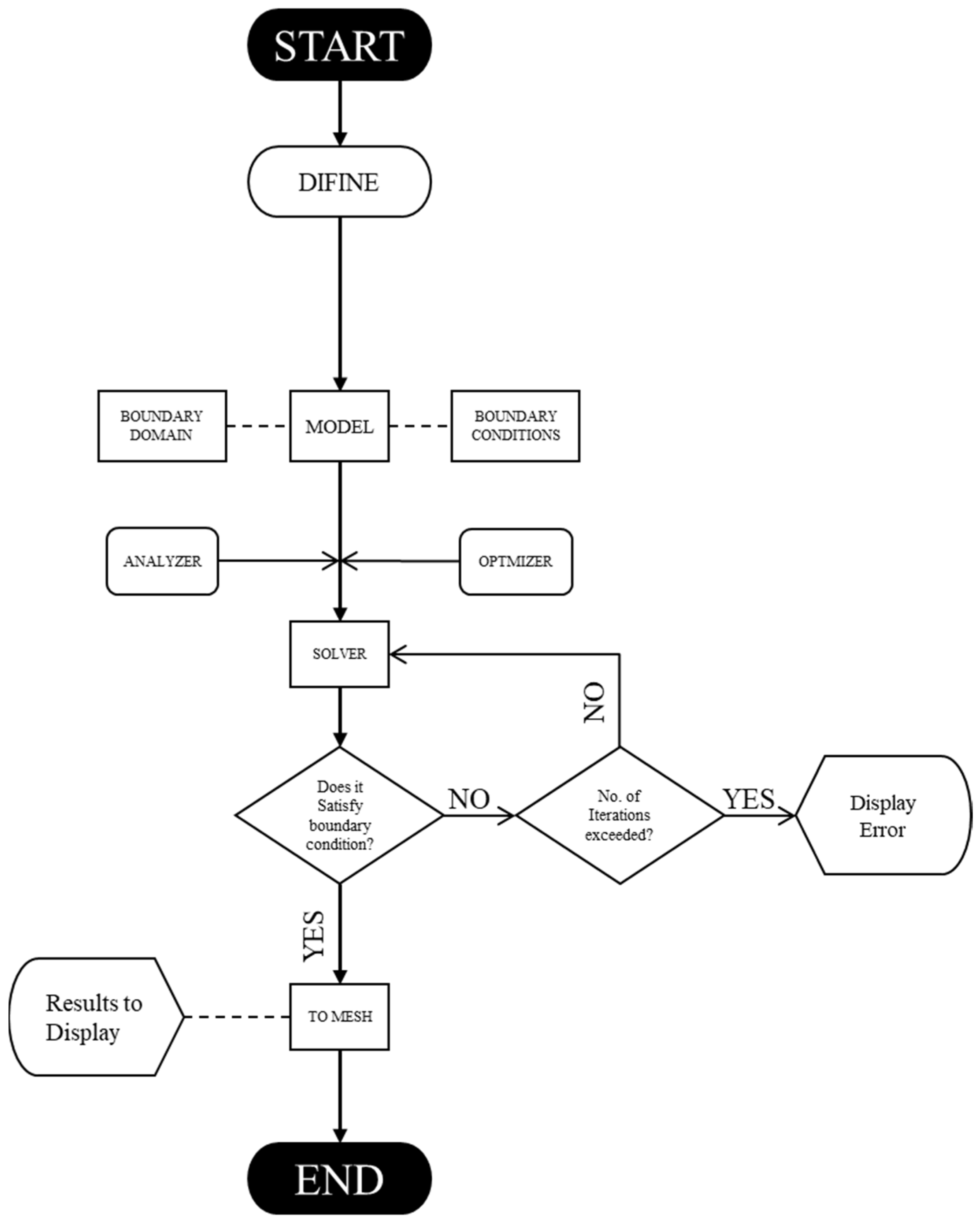
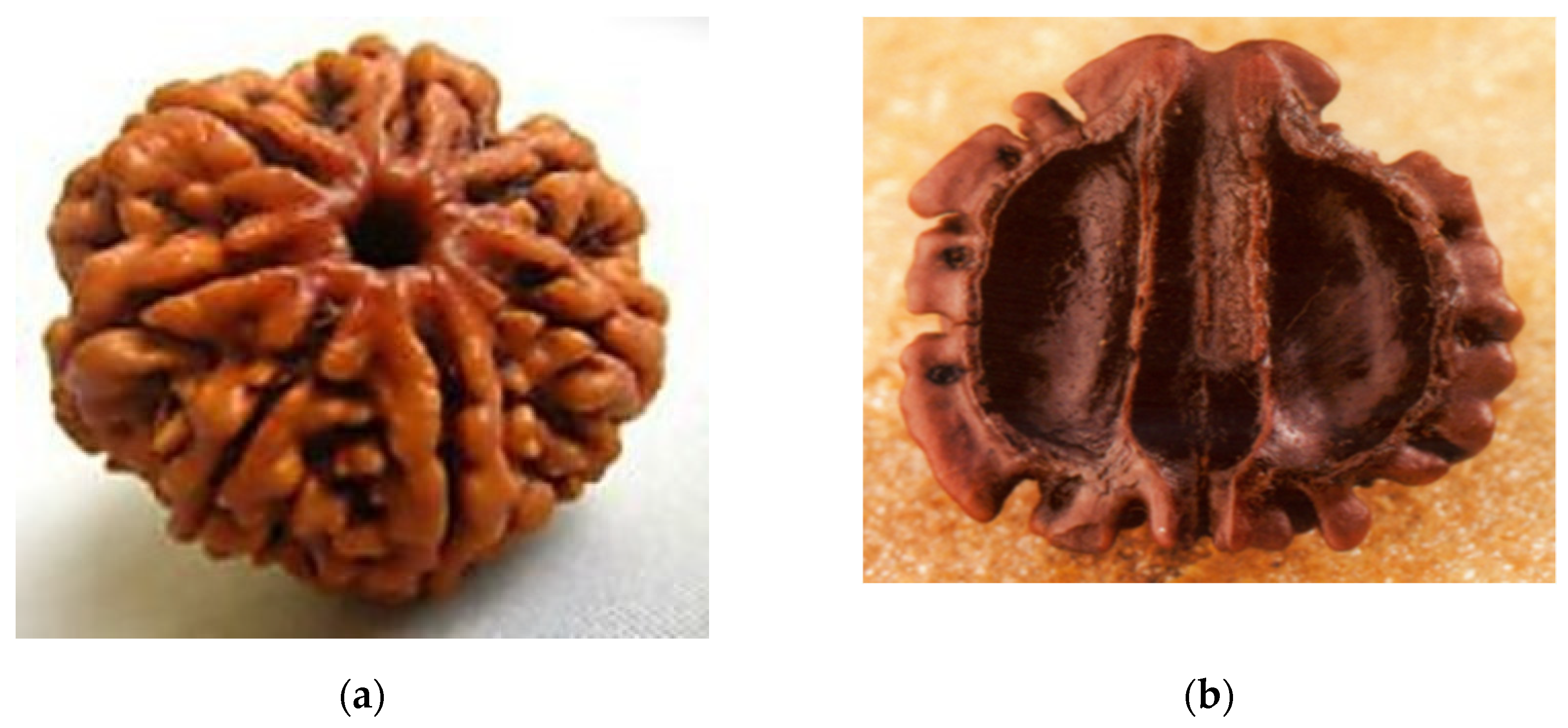
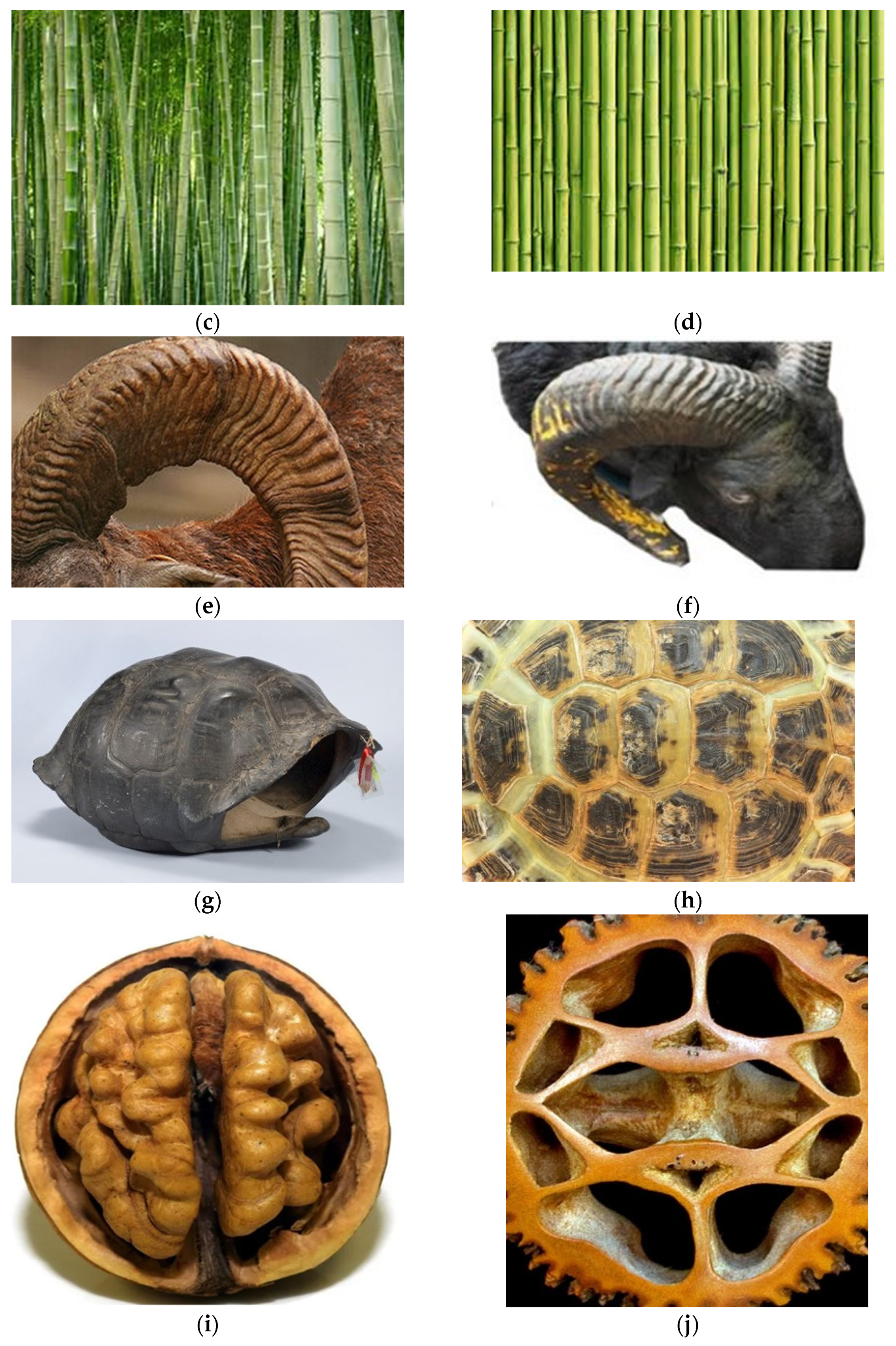






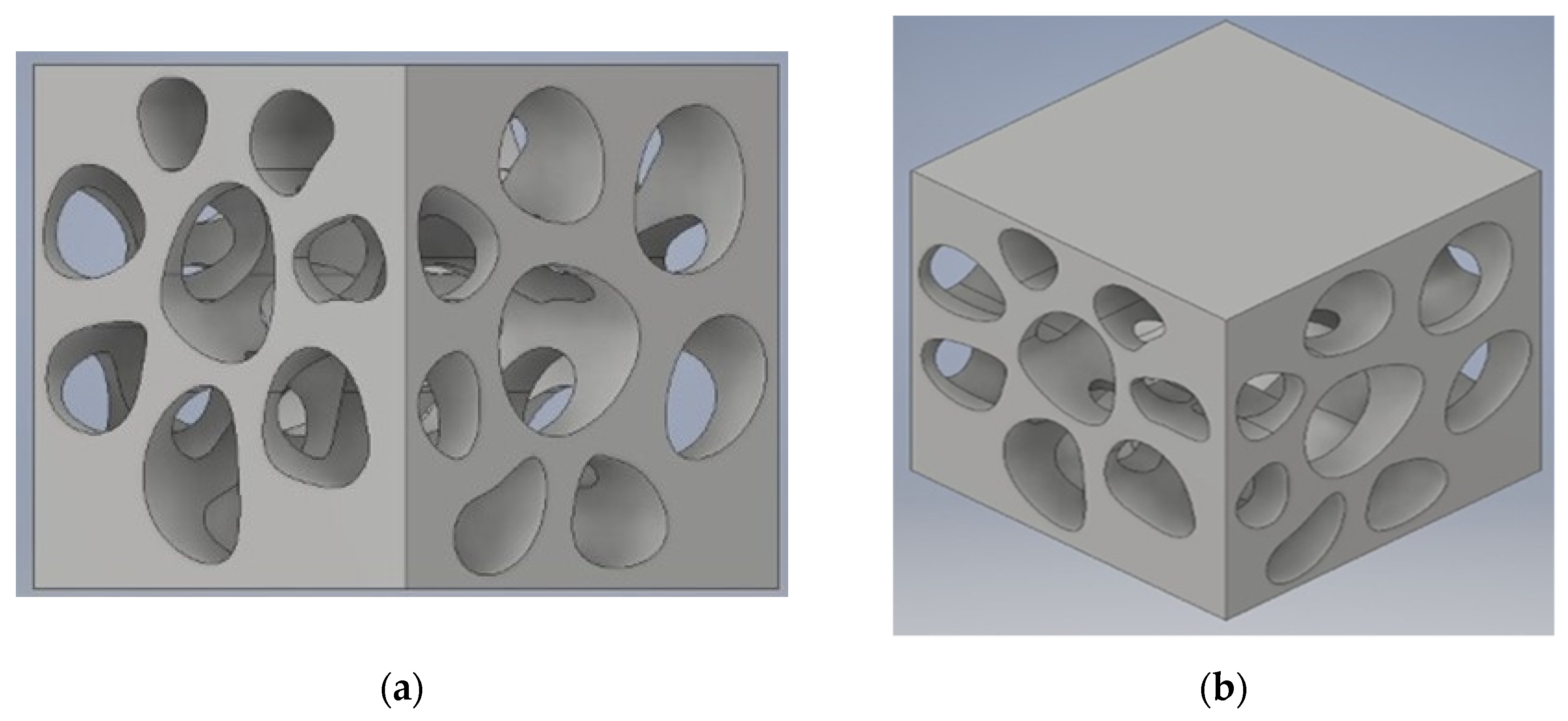
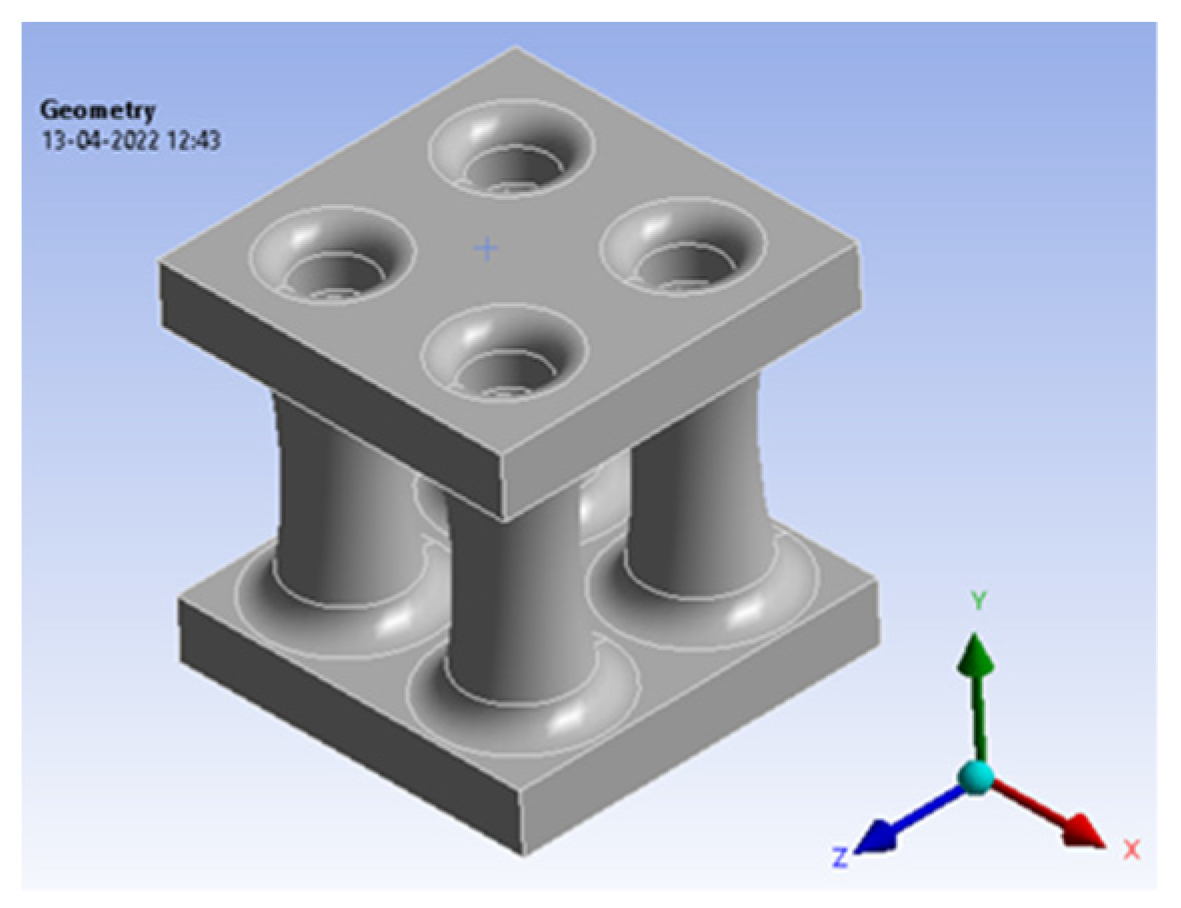
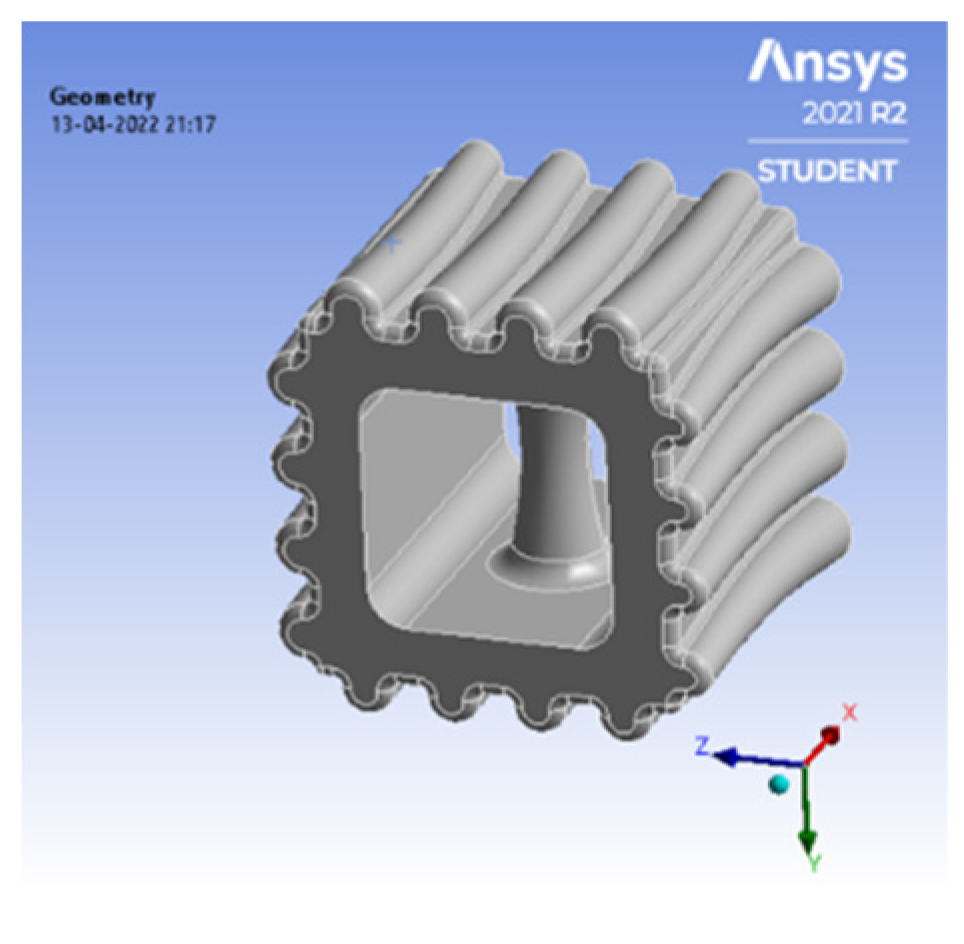
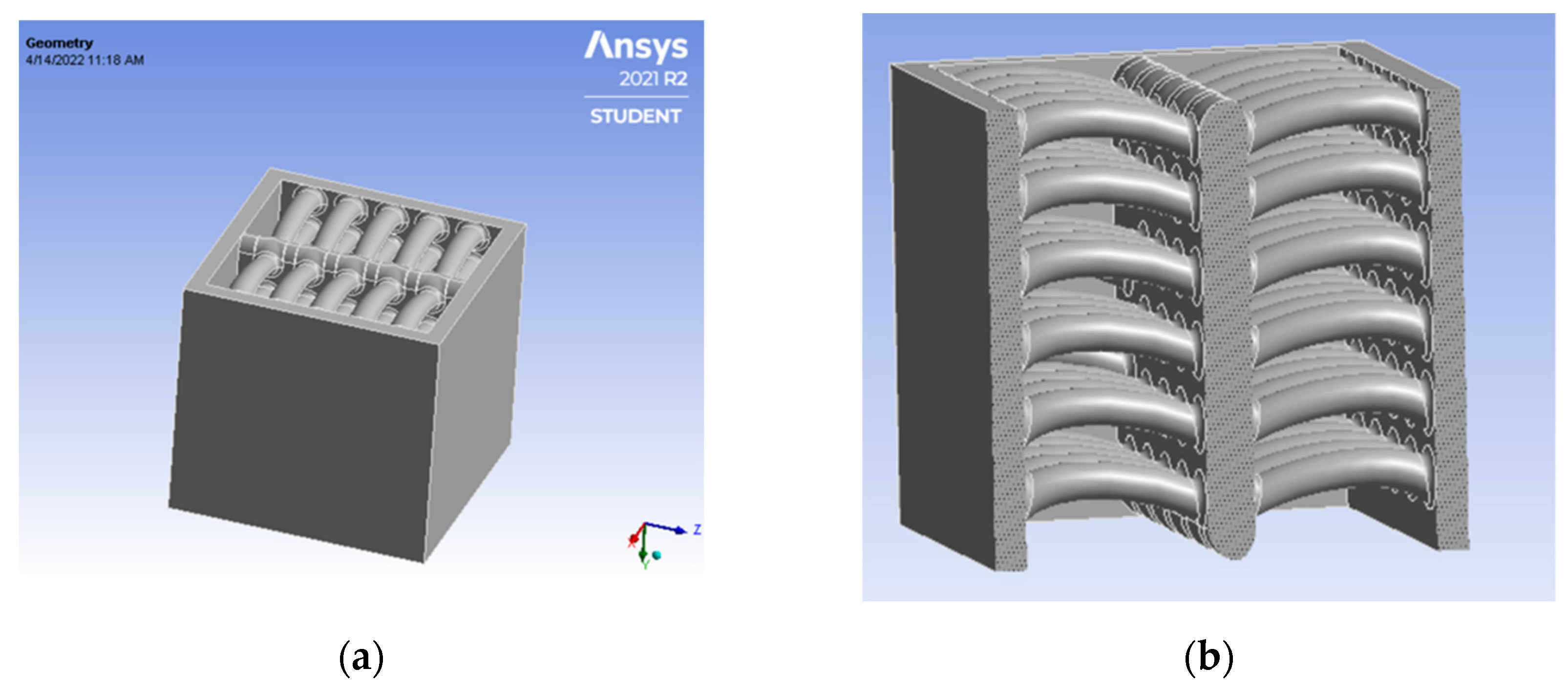


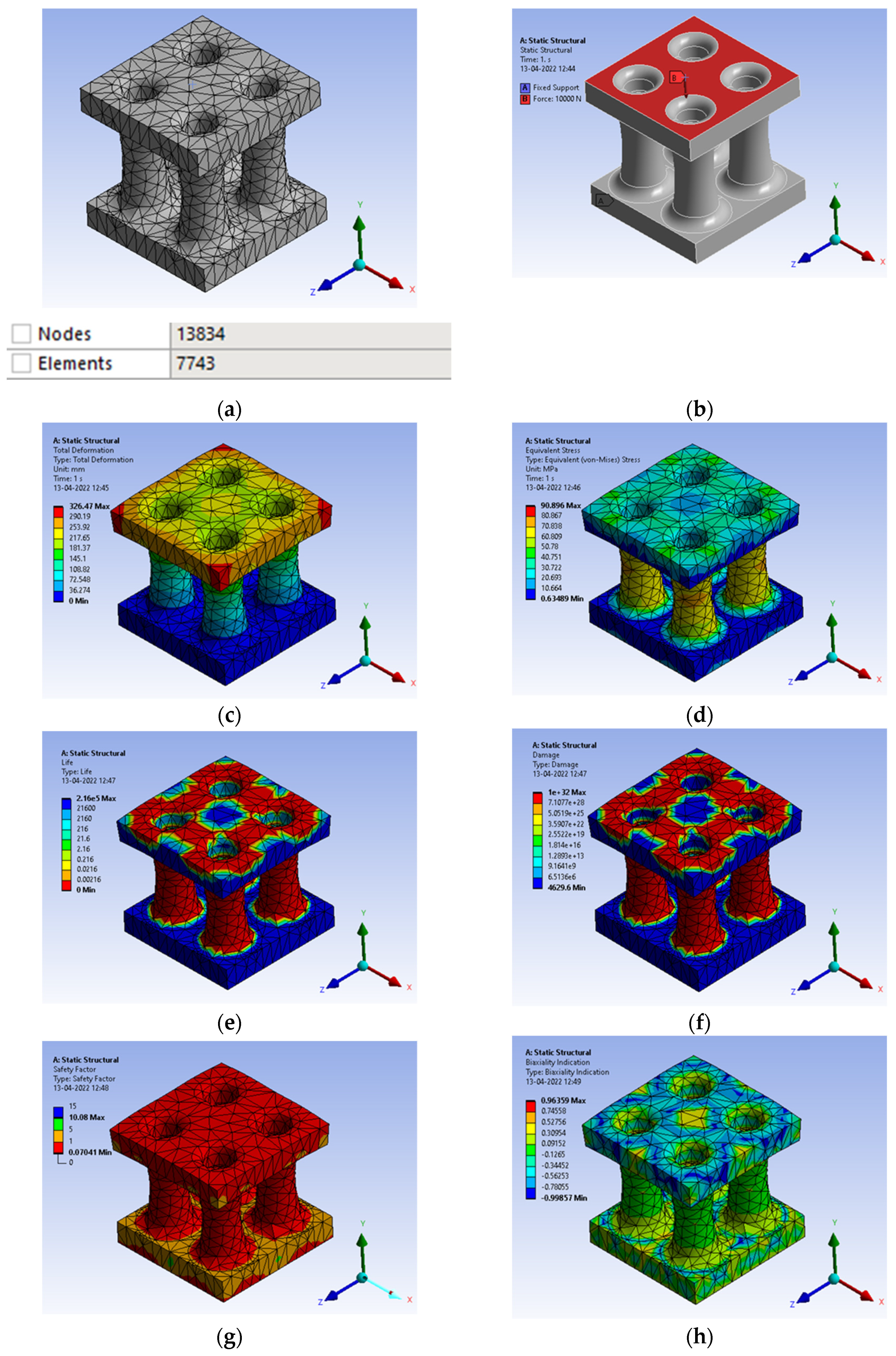

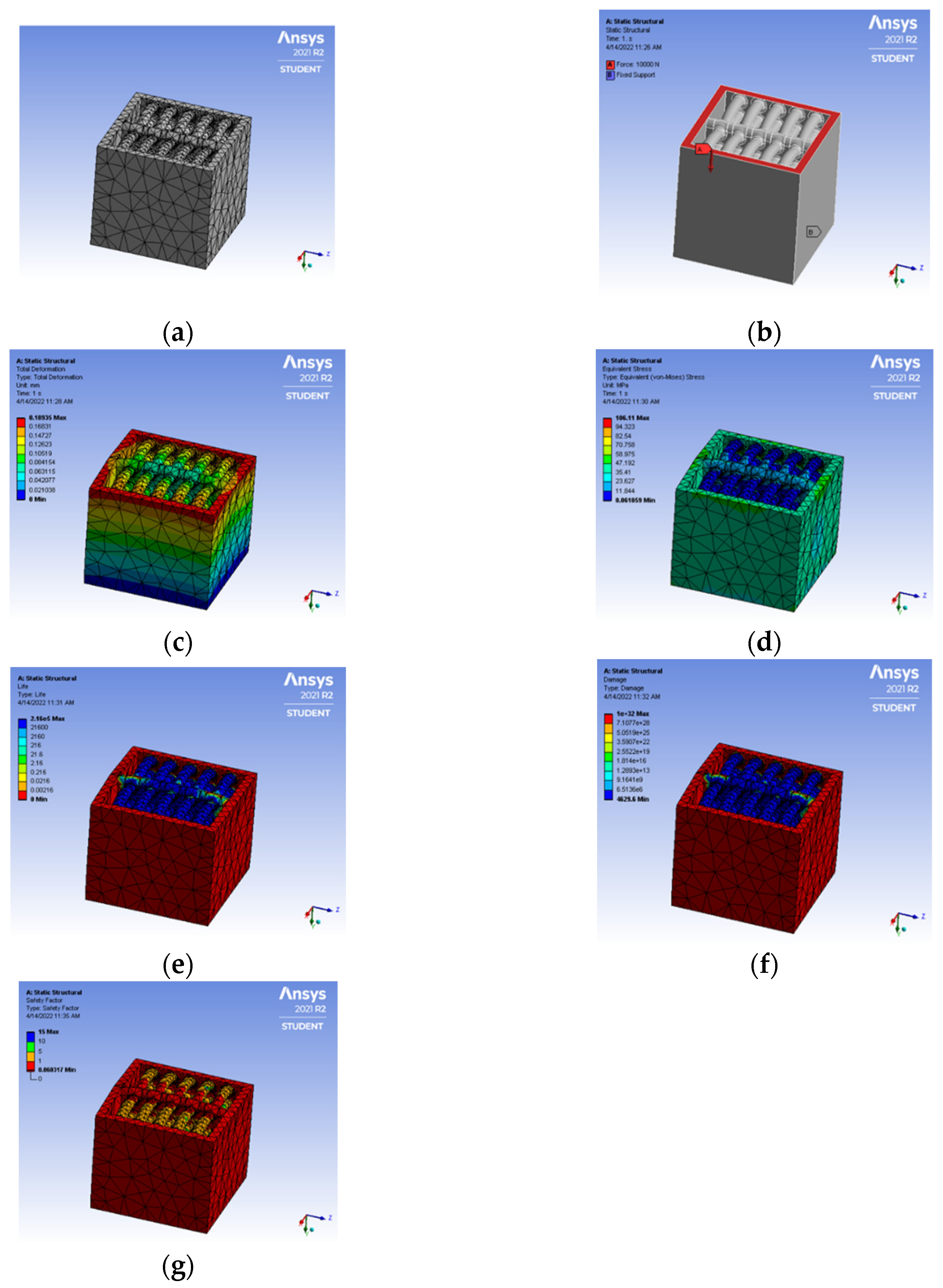
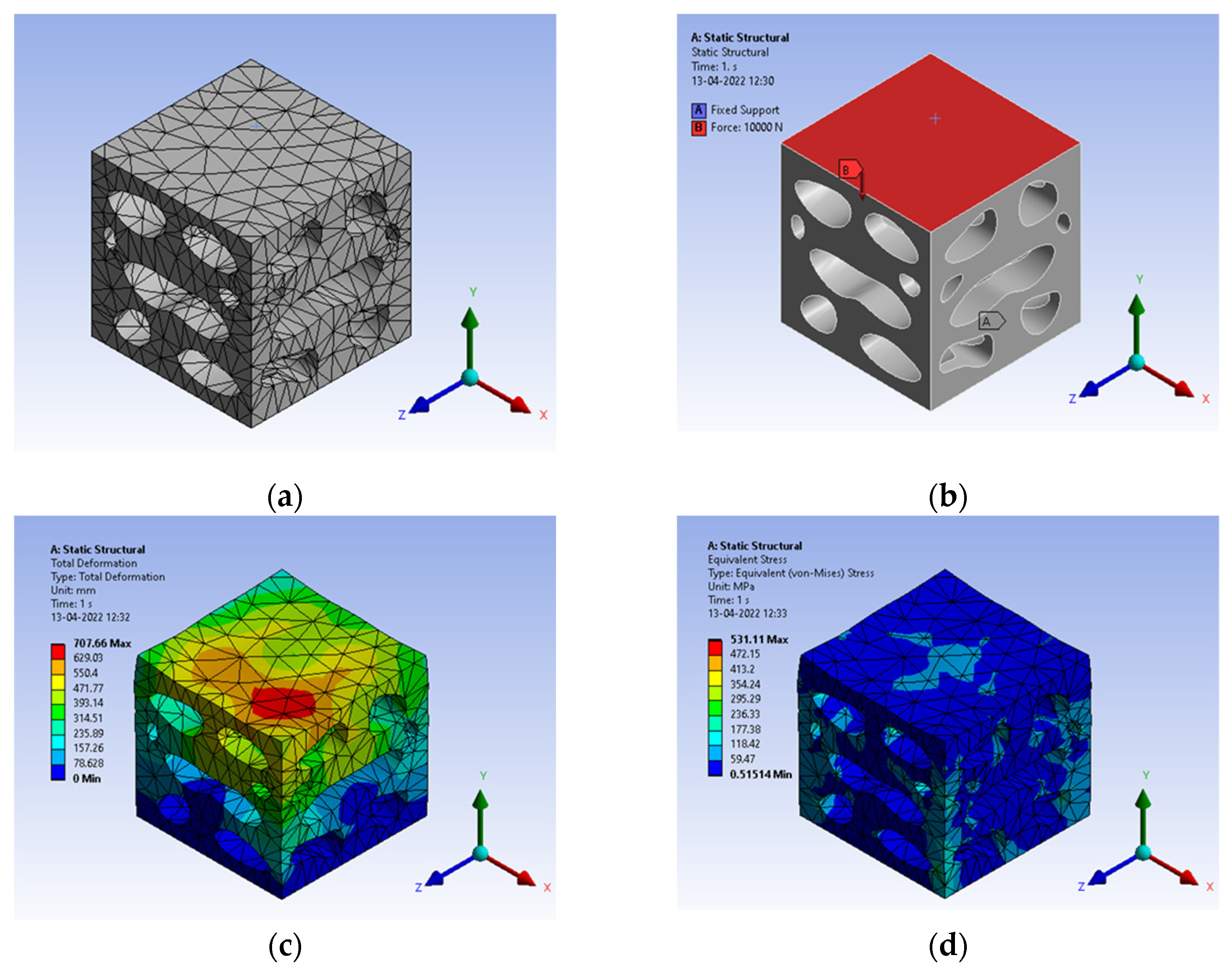
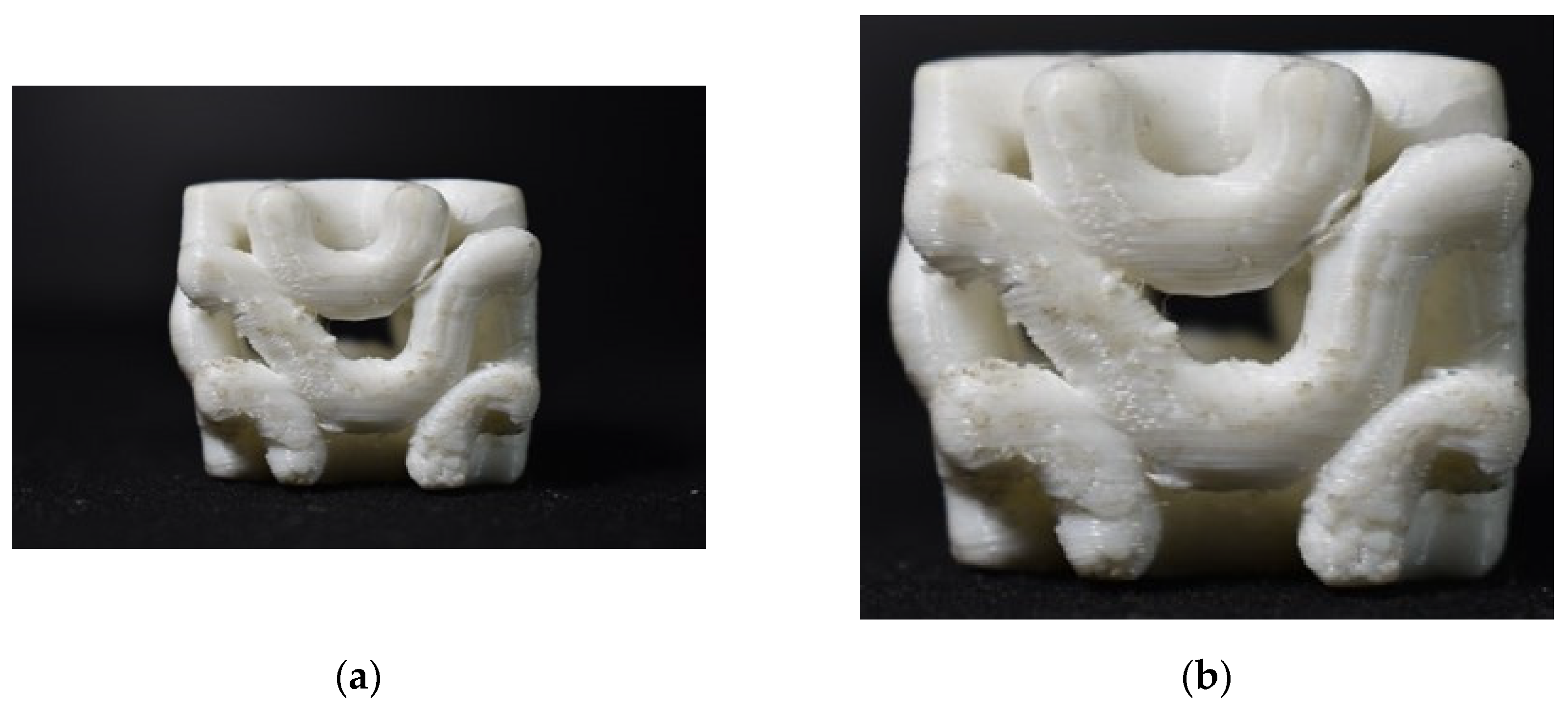
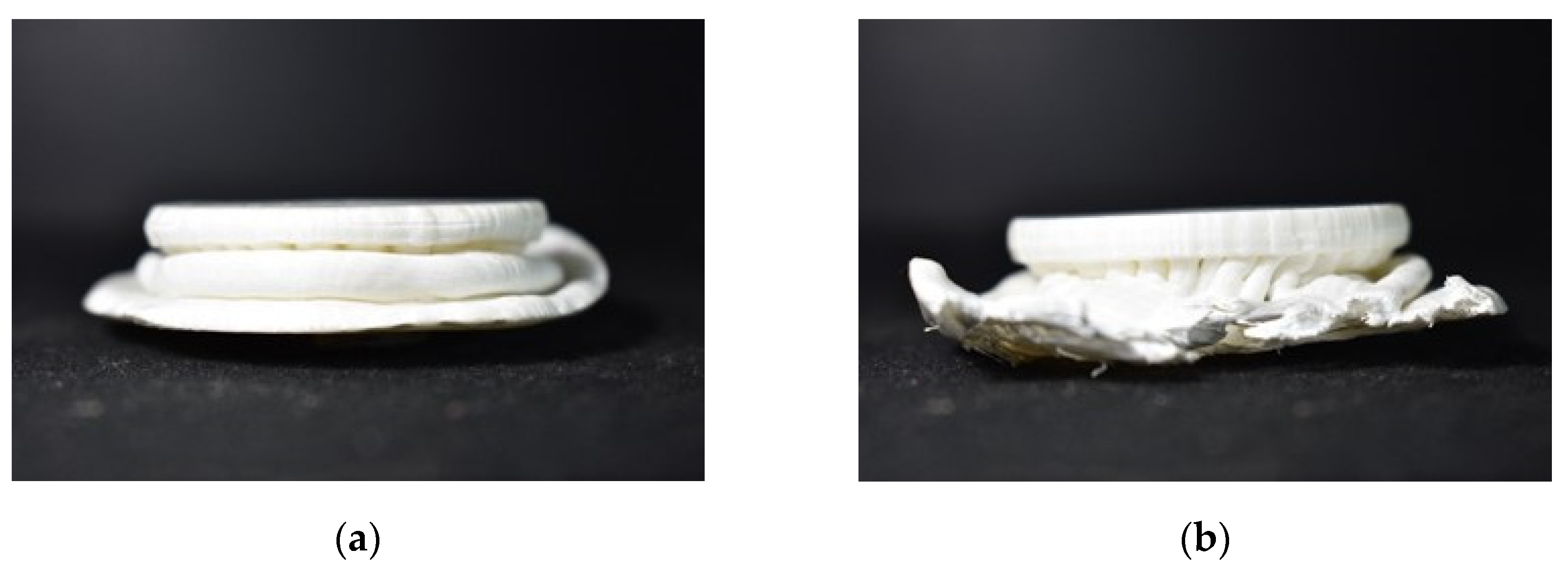
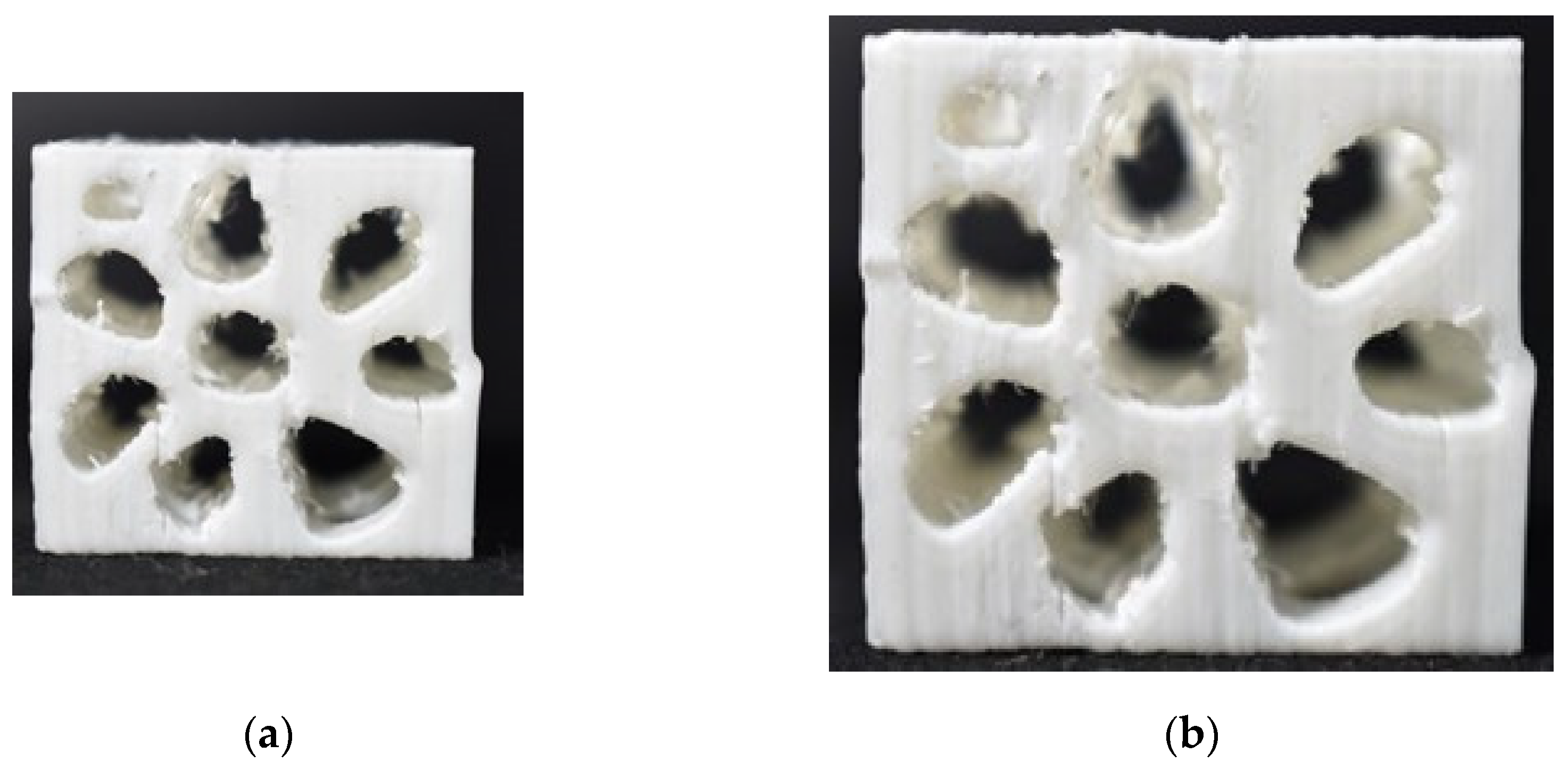
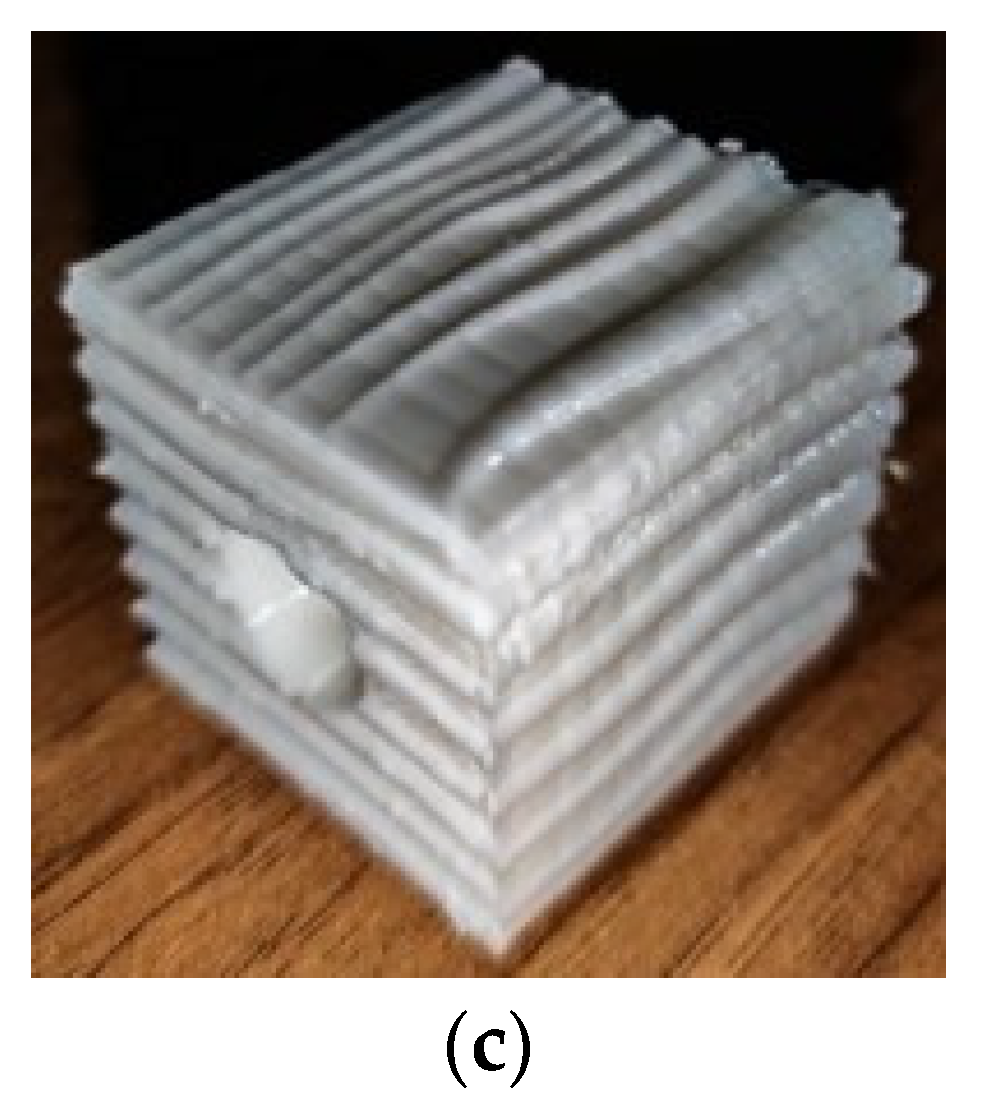
| Sl No | Title | Author and Year | Description (Test Conducted) | Pattern Images |
|---|---|---|---|---|
| 1 | Bio-inspired columns mimicking beetle forewing structure (review paper) | Xiang and Du [35], 2017 | The specific energy absorption of the bio-inspired multi-cell tubes (BMTs) with a length of 50 mm, a velocity of 10 m/s, and a mass of 500 kg increased by 9.79 percent and 35.97 percent, respectively, as compared to the standard A velocity of 10 m/s for impact. When compared to the traditional structure, the Specific Energy Absorption (SEA) of the BMTs (b), (c), and (d) rose by 90.56 percent, 68.33 percent, and 107.68 percent, respectively (a). | 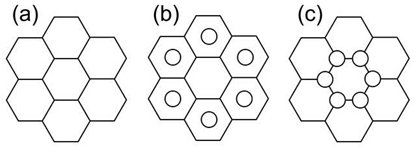 |
| Hao and Du [36], 2018 | The length and diameter of the columns were 200 mm and 377 mm, respectively, and absorption properties improved at a velocity of 10 m/s and a mass of 500 kg. | 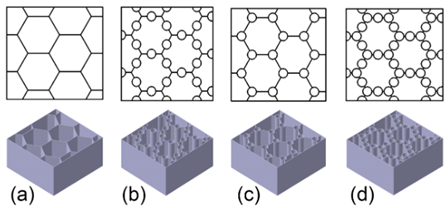 | ||
| Xiang et al. [37], 2017 | The specific energy absorption of the bio-inspired multi-cell tubes (BMTs) with a length of 50 mm, a velocity of 10 m/s, and a mass of 500 kg increased by 9.79 percent and 35.97 percent, respectively, as compared to the standard A velocity of 10 m/s for impact. When compared to the traditional structure, the Specific Energy Absorption (SEA) of the BMTs rose by 90.56 percent, 68.33 percent, and 107.68 percent, respectively (a). |  | ||
| Yu et al. [38], 2018 | The SEA of the bio-inspired hexagonal structures was 5× that of a corrugated square box. | 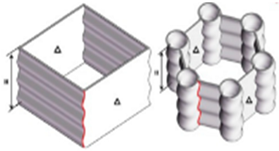 | ||
| 2 | Bio-inspired multi-cell conical tube mimicking ox horn structure. | Meng et al. [39], 2015 | The SEA of the bio-inspired tube was 46.2 kJ/kg, which was about 1.3 times and 1.8 times greater than that of four cell conical tube and conical tubes. |  |
| 3 | Microstructure of a woodpecker’s beak to design a novel BSP | Ha et al. [40], 2019 | The SEA increased by 125% and 63.7%. | 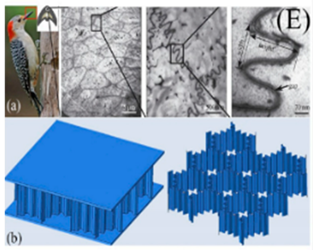 |
| 4 | Date palm leaf fibre (DPLF) | Mahdi et al. [41], 2019 | The SEA of DPLF unidirectional reinforced epoxy composites rectangular tubes was 10.3 kJ/kg. | 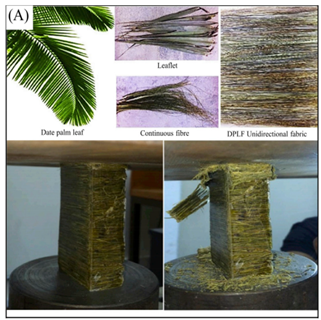 |
| 5 | On the crashworthiness of bio-inspired hexagonal prismatic tubes under axial compression | Wang [42], 2020 | Bio-inspired hexagonal prismatic tubes with a height of 120 mm and with different interior cell arrangements, with a velocity of 10 m/s impacted a plate and a tube. Increasing the SEA about 2.5 times the normal hexagonal prism. This study also shows variation in EA and axial compression with respect to geometrical structures of the same and different weights. |  |
| 6 | Experimental study on the crashworthiness of bio-inspired aluminum foam-filled tubes under axial compression loading | Jiafeng Song [43], 2020 | Based on two typical straw structures (Cornstalk and Reed), four types of bio-inspired foam-filled thin-walled structures were created. | 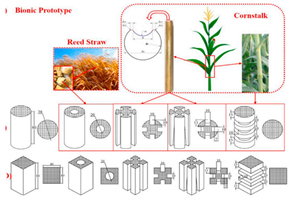 |
| 7 | Separating the influence of the cortex and foam on the mechanical properties of porcupine quills | Wen Yang, Joanna McKittrick [44], 2013 | The experimental value of the Buckling strength of the Hystrix structure with cortices is 135.2 + 29.6 MPa or 135.2−29.6 MPa and the theoretical value is 83.9 MPa (for E = 2.6 GPa). Simiar to the Experimental Buckling strength of the Erethizon is 19.9 + 8.5 MPa or 19.9 − 8.5 MPa and the theoretical value is 26 MPa (for E = 1 GPa). The modulus for the Hystrix cortex is 2.6 times higher than for the Erethizon cortex (1 GPa). |  |
| 8 | Bio-inspired energy-absorbing material designs using additive manufacturing | Aniket Ingrole [45], 2021 |
| 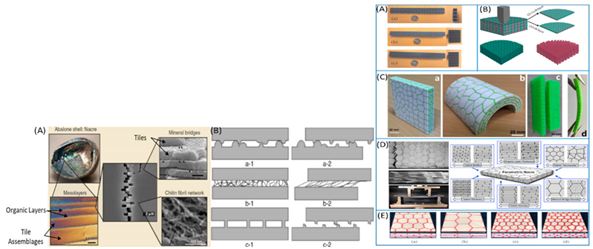 |
| 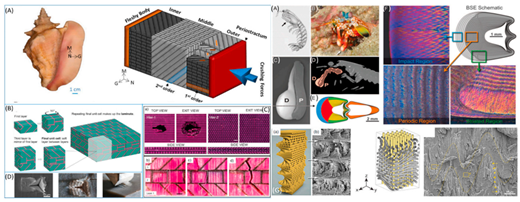 | |||
| 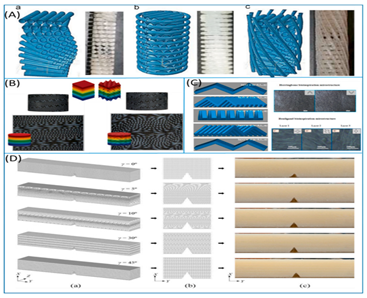 | |||
| 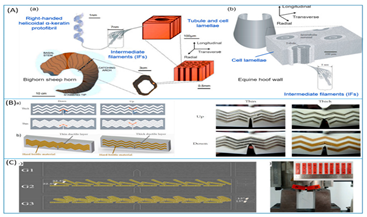 | |||
| 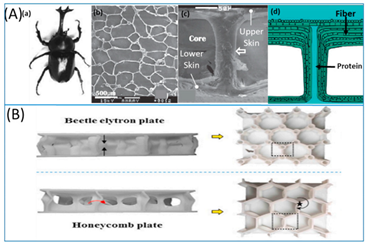 | |||
| 9 | Hierarchical structure and compressive deformation mechanisms of bighorn sheep (Ovis canadensis) horn | Wei Huang [46], 2017 | Impact force = 3400 N, velocity 9 m/s strain rate of order-102–103. Young’s modules 0.65 to 2.2 GPa for X-ray-size 2 × 2 × 4 mm3. From impact area, impact area thickness 2 cm, inner thickness 1 cm. Optical and scanning electron microscopy imaging and compression test-size-4 × 4 × 4 mm3, 5 mm from import surface. Transmission electron microscopy imaging -size 2 × 1 × 1 mm3. Young’s modulus increases in the day state 2–3 times when the strain rate changes from 1 × 103/s to 4 × 103/s. Radial direction (impact direction) was found to have the highest strength and energy absorption, inspired by a design of recoverable energy-absorbing material. | 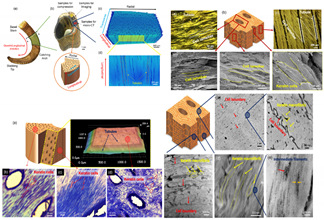 |
| 10 | Design optimisation of a novel bio-inspired 3D porous structure for crashworthiness | Hanfeng Yin [47], 2020 | Four types of H3DP [Hierarchical 3D porous] porous material are popular types of materials and are lightweight, have excellent sound absorption, and have high impact energy absorption. Based on the quasistatic simulation, structures with different lattice configurations ranging from 4 × 4 × 4 to 7 × 7 × 7 tessellating cells are investigated. An Instron 8802 universal test machine is used to perform the quasistatic compression test on the H3DP structure. The bottom plate simply supports the lattice samples, while the upper platform is crushed at a rate of 0.2 mm/min. |  |
| 11 | Energy absorption of bio-inspired multi-layered graded foam-filled structures under axial crushing | Xinmei Xiang [48], 2020 | Model-1 with graded foam filler exhibited larger SEA (specific energy absorption). Model-1 (250-400-550) is considered the best design for the foam-filled structures investigated in this study. Values: EA = 2590.2 J, CFE = 66%. | 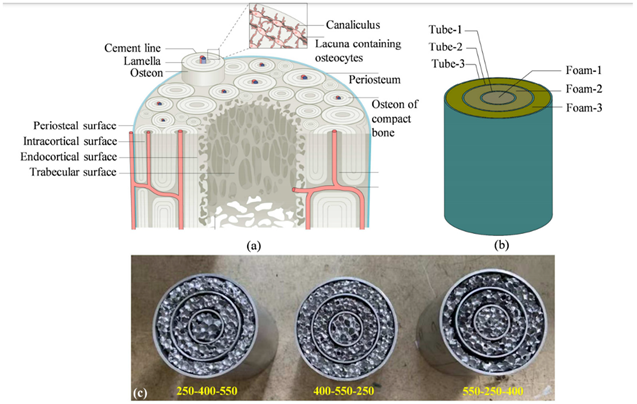 |
| 12 | A review of the impact-resistant biological and bioinspired materials and structures | Benjamin S. Lazarus [49], 2020 | Keratin scutes easily delaminate and deflect cracks, toughening the shell. Young’s modulus of these layers are about 20 GPa and 1 GPa, respectively. On the human skull, shear punch tests were performed at strain rates of 0.001 s−1 and 0.1 s−1. The skull of a woodpecker. Conch shells dissipate energy as well by causing cracks to meander. The conch shell has a 67 percent higher fracture strength when tested at a strain rate of 103 s−1 than when tested at a strain rate of 104 s−1. The third-order lamellae fracture and splinter away under impact loading. | 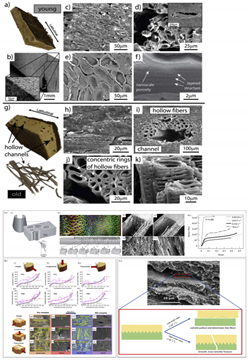 |
| 13 | Experimental and numerical assessment of sustainable bamboo core sandwich panels under low-velocity impact | Lívia Ávila de Oliveir [50], 2021 | Sandwich panels were subjected to a drop test with a 16 mm diameter hemispherical impactor. A mass of 9.46 kg is dropped at 3.25 m/s on the sandwich panels. A finite element model of the drop test simulation was also conducted at 20-Epoxy-Max load (kN) = 4.5, total deflection (mm) = 22.80, 20-Biopolymer-Max load (kN) = 6.29, and total deflection(mm) = 11.49. | 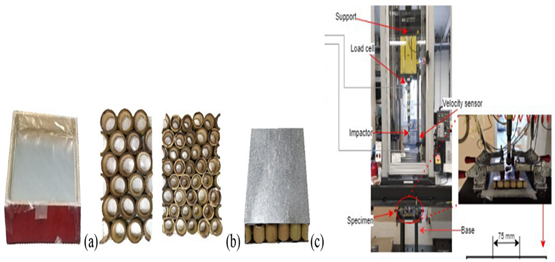 |
| 14 | Laser additive manufacturing of bio-inspired lattice structure. Forming quality, microstructure, and energy absorption behaviour | Yuexin Du [51], 2019 | AlSi10Mg alloy powder was used as the raw material in this study, Fmax (2.95 kN) with a displacement value (1.18 mm) at 375 W. As the laser power increased to 400 W or 450 W, the accumulated displacement drastically decreased. At the end of stage II, the force dropped sharply accompanying the failure of a certain strut occurred. | 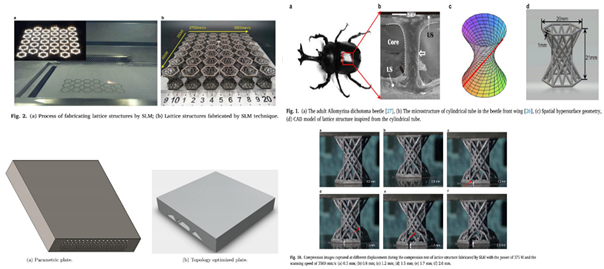 |
| 15 | Through-thickness perforated steel plates optimised for ballistic impact applications | Francisco Javier Ramírez-Gil [52], 2021 |
| 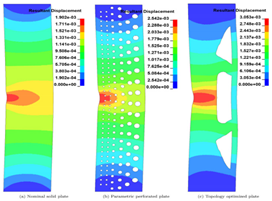 |
| Pattern | Ultimate Force (lbf) | Ultimate Stress (psi) |
|---|---|---|
| Standard (50% fill) | 2381.12 | 2173.28 |
| Rudraksh | 789.13 | 720.25 |
| AGM | 1293.39 | - |
| Bendsoe and Sigmund model | 2222.42 | 707.42 |
| Pattern | Total Deformation (mm) | Maximum Principal Stress (MPa) | Fatigue Life Cycle | Factor of Safety |
|---|---|---|---|---|
| Rudraksh | 1129.3 | 657.95 | 2.16 × 105 | 0.09 |
| Bambusa tulda | 326.47 | 90.89 | 2.16 × 105 | 0.07 |
| Sheep horn | 0.338 | 145.44 | 1 × 106 | 0.593 |
| Tortoiseshell | 0.189 | 106.11 | 1 × 106 | 0.058 |
| Juglans nigra | 707.66 | 531.11 | 2.16 × 105 | 0.009 |
| Type | Material | ||
|---|---|---|---|
| Structural Steel | Sheep Horn | PLA | |
| Total deformation | 0.010273 mm | 326.47 mm | 0.68835 mm |
| Equivalent stress | 92.83 mm | 90.896 MPa | 95.387 |
| Fatigue life | Max − 1 × 106 Min − 0 | Max − 2.16 × 105 Min − 0 | |
| Fatigue Damage | 1532.1 | 1 × 1032 | |
| Fatigue safety factor | Max 15 Min 0.92857 | Max 10.08 Min 0.07041 | |
| Biaxiality indication | Max 0.97225 Min − 0.97544 | Max 0.96359 Min − 0.99996 |
| Results | Structural Steel | Sheep Horn | PLA |
|---|---|---|---|
| Total Deformation | 0.036271 mm | 1129.3 mm | 2.6932 mm |
| Equivalent Stress | 659.08 MPa | 657.95 MPa | 1049.4 MPa |
| Life | 1 × 106 − Max 703.46 − Min | 2.16 × 105 − Max 0 − Min | |
| Damage | 1.42 × 106 − Max 1000 − Min | 1 × 1032 − Max 4629.6 − Min | |
| Safety | 15 − Max 0 − Min | 15 − Max 0 − Min | |
| Biaxiality Indication | 0.988 − Max −0.99 − Min | 0.98822 − Max − 0.99967 − Min |
| Results | Structural Steel | Sheep Horn | PLA |
|---|---|---|---|
| Total deformation (mm) | 0.011245 | 0.33809 | 0.711 |
| Equivalent stress (Mpa) | 130.7 | 145.44 | 172.49 |
| Strain Energy (mJ) | 0.43981 | 13.714 | |
| Life | Max: 1 × 106 Min: 1.281 × 105 | Max: 1 × 106 Min: 82,488 | |
| Damage | Max: 8209.6 Min: 1000 | Max: 12,133 Min: 1000 | |
| Safety factor | Max: 15 Min: 0 | Max: 15 Min: 0 | |
| Biaxiality Indicator | Max: 0.9859 Min: − 0.999 | Max: 0.98333 Min: −0.999 |
| Results | Sheep Horn | Structural Steel | PLA |
|---|---|---|---|
| Total deformation (mm) | 0.18936 | 6.1907 × 10−6 | 0.41234 |
| Equivalent stress (MPa) | 106.11 | 1.2653 × 108 | 89.819 |
| Life | Max: 2.16 × 105 Min: 0 | 1 × 106 1.3698 × 105 | |
| Damage | Max: 1 × 1032 Min: 4629.6 | 7300.1 1000 | |
| Safety factor | Max: 15 Min: 0.06 | 15 0.6 |
| Results | Sheep Horn | Structural Steel | PLA |
|---|---|---|---|
| Total deformation (mm) | 0.034741 mm | 0.08722 mm | 2.3286 mm |
| Equivalent stress (MPa) | 1680.1 MPa | 1424.5 MPa | 1690.6 MPa |
| Life | Max 1 × 106 Min (0 cycles) | Max 0 Min 0 | |
| Damage | 1.5041 × 107 | 1 × 1032 | |
| Safety factor | Max 15 | Max 15 |
Publisher’s Note: MDPI stays neutral with regard to jurisdictional claims in published maps and institutional affiliations. |
© 2022 by the authors. Licensee MDPI, Basel, Switzerland. This article is an open access article distributed under the terms and conditions of the Creative Commons Attribution (CC BY) license (https://creativecommons.org/licenses/by/4.0/).
Share and Cite
Patil, A.Y.; Hegde, C.; Savanur, G.; Kanakmood, S.M.; Contractor, A.M.; Shirashyad, V.B.; Chivate, R.M.; Kotturshettar, B.B.; Mathad, S.N.; Patil, M.B.; et al. Biomimicking Nature-Inspired Design Structures—An Experimental and Simulation Approach Using Additive Manufacturing. Biomimetics 2022, 7, 186. https://doi.org/10.3390/biomimetics7040186
Patil AY, Hegde C, Savanur G, Kanakmood SM, Contractor AM, Shirashyad VB, Chivate RM, Kotturshettar BB, Mathad SN, Patil MB, et al. Biomimicking Nature-Inspired Design Structures—An Experimental and Simulation Approach Using Additive Manufacturing. Biomimetics. 2022; 7(4):186. https://doi.org/10.3390/biomimetics7040186
Chicago/Turabian StylePatil, Arun Y., Chandrashekhar Hegde, Guruprasad Savanur, Sayed Mohammed Kanakmood, Abhishek M. Contractor, Vinay B. Shirashyad, Rahul M. Chivate, Basavaraj B. Kotturshettar, Shridhar N. Mathad, Mallikarjunagouda B. Patil, and et al. 2022. "Biomimicking Nature-Inspired Design Structures—An Experimental and Simulation Approach Using Additive Manufacturing" Biomimetics 7, no. 4: 186. https://doi.org/10.3390/biomimetics7040186








